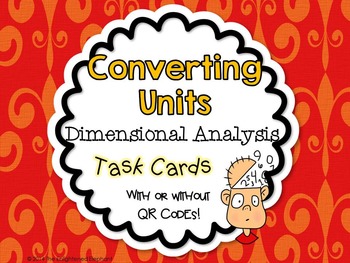Converting Units Dimensional Analysis Task Cards
The Enlightened Elephant
8.5k Followers
Resource Type
Standards
CCSSHSN-Q.A.1
Formats Included
- Zip
Pages
15 pages
The Enlightened Elephant
8.5k Followers
What educators are saying
I love having students use these in groups. I wish the solutions were worked out step by step. It would help with error analysis when I'm trying to check students' work quickly. Still a great resource!
My students loved the way this was set up! I used this for tutoring and it was simplified enough so they were able to understand the process, rather than get bogged down in the numbers.
Description
There are 20 total task cards plus a measurement equivlancies reference sheet and a student recording sheet. These tasks meet HS.N-Q.A.1.
There are 9 multiple choice questions that require students to select the correct set of conversion factors to convert units in the context of the problem. In addition, there are 11 task cards that require students to answer question about converting rates that require the use of dimensional analysis, or conversion factors. Cards come with or without QR codes.
Use task cards at centers or stations, and for activities like “scoot”, scavenger hunts or other similar activities. You can also print multiple sets and use as question cards with game boards.
Answer key included.
YOU MAY ALSO LIKE
Writing Conversion Factors
Factor GCF of Polynomials Task Cards
Quadratic Word Problems Task Cards
Simplify Radicals Task Cards
X and Y Intercepts and Graphing Lines Task Cards
Factor Trinomials (a =1) Task Cards
There are 9 multiple choice questions that require students to select the correct set of conversion factors to convert units in the context of the problem. In addition, there are 11 task cards that require students to answer question about converting rates that require the use of dimensional analysis, or conversion factors. Cards come with or without QR codes.
Use task cards at centers or stations, and for activities like “scoot”, scavenger hunts or other similar activities. You can also print multiple sets and use as question cards with game boards.
Answer key included.
YOU MAY ALSO LIKE
Writing Conversion Factors
Factor GCF of Polynomials Task Cards
Quadratic Word Problems Task Cards
Simplify Radicals Task Cards
X and Y Intercepts and Graphing Lines Task Cards
Factor Trinomials (a =1) Task Cards
Total Pages
15 pages
Answer Key
N/A
Teaching Duration
N/A
Report this resource to TPT
Reported resources will be reviewed by our team. Report this resource to let us know if this resource violates TPT’s content guidelines.
Standards
to see state-specific standards (only available in the US).
CCSSHSN-Q.A.1
Use units as a way to understand problems and to guide the solution of multi-step problems; choose and interpret units consistently in formulas; choose and interpret the scale and the origin in graphs and data displays.





